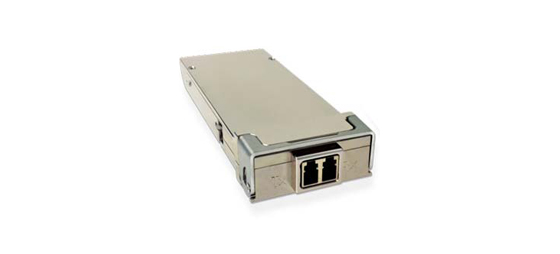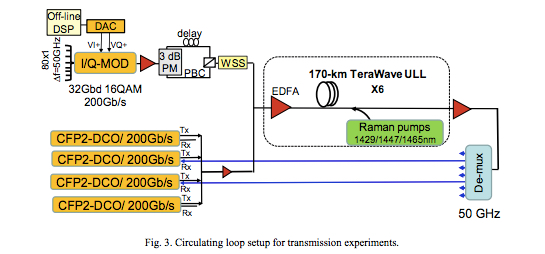Achieving record low power consumption per bit for coherent optical transceivers
Transmission reaches for metro applications have to be above 50 km for metro/access and below 1000 km for metro/regional applications. This requires compact, scalable, cost-efficient, and easy-to-use digital coherent transport solutions such as the Acacia CFP2 module.

Figure 1: CFP2 coherent module
Acacia’s engineering team led by Hongbin Zhang recently demonstrated real-time transmission of 16 Tb/s (80x200Gb/s) over 1020km TeraWave ULL fiber with 170km span length using the 200Gb/s CFP2 module. The length, while much longer than typical metro/regional spans, was chosen to stress the OSNR budget while showing achievable amplifier spacing with ultra-low loss fiber. The results showed a record low power consumption less than 0.1W/Gbps. This is the lowest reported power consumption per bit for coherent optical transceivers.

Figure 2: Circulating loop setup for transmission experiments.
For the purpose of this experiment the CFP2 module was implemented in multi-source agreement (MSA) 107.5 mm x 41.5 mm form factor. Test specifics include:
- To test the 200Gb/s transmission performance as a function of OSNR for PM-8QAM on a 50GHz grid (4 bits/s/Hz SE) and PM-16QAM on a 37.5GHz grid (5.33 bits/s/Hz SE), we placed the 4 CFP2 channels next to each other in the middle of the C-band. One of the middle CFP2 channels was selected by a 50GHz optical demux in front of the coherent receiver and the real-time BER was measured as a function of received OSNR by varying the EDFA output power and subsequently converted into Q2-factor.
- To test the transmission performance as a function of the wavelength, we determined the Q2-factor from the measured real-time BER of the two middle channels among 4 consecutive CFP2 50GHz-spaced channels as they are moved across the C-band.
Relying on pluggable CFP2 transceiver modules, we were able to demonstrate successful 200Gb/s real-time transmission of 80 PM-8QAM and PM-16QAM channels at 4 bits/s/Hz spectral efficiency over 1020 km distance using very long 170km spans of TeraWave ULL fiber showing 2.8dB and 1.2dB Q2-margin, respectively. We were also able to prove an increase in system capacity as well as a decrease in power consumption per bit for coherent optical transceivers.
The research paper, published by Optics EXPRESS, is available to read or download here.
